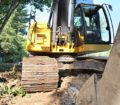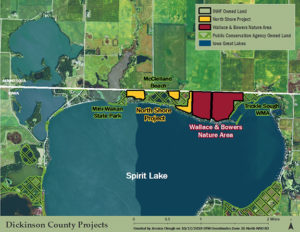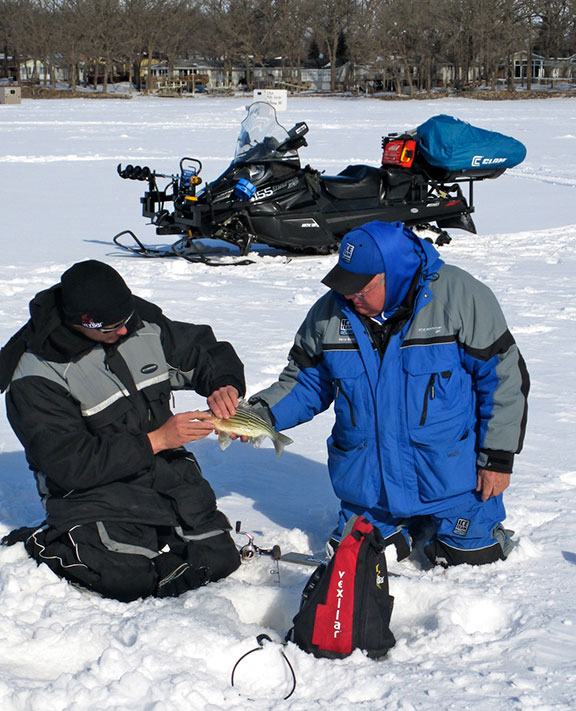By Steve Weisman
Big Spirit Lake, the largest natural lake in Iowa, is a true fishing and recreation destination. Much work has been done over the years to address the issue of runoff into the lake. A series of conservation projects over the past year have come together to protect key lands along the north shore of the lake.
Spearheaded by the Iowa Natural Heritage Foundation (INHF), the INHF has purchased four parcels of land since 2018. First came the Wallace and Bowers Nature Area in 2018 and most recently three parcels of land adjacent to the Iowa DNR’s McClelland Beach Wildlife Management Area. All of these are critical in protecting the lake from runoff issues with all lying within a quarter-mile of Big Spirit Lake. They are truly the last line of defense before runoff hits the lake. Anita O’Gara, Vice President for the INHF, says, “This creates one of the largest contibuous stretches of protected land along any of the Iowa Great Lakes, with lasting benefits for water, soil, wildlife, outdoor recreation and the community.”
Wallace and Bowers Nature Area
The 160-acre parcel known as the Wallace and Bowers Nature Area that was purchased in 2018 to be restored and managed primarily for water quality benefits. The generosity of two families made this possible: Jeff and Elizabeth Wallace and the children of Clifford and Sheila Bowers (Barbara Mendenhall, Abby Adams and Bert Bowers). However, it is not going to be simply tall grass prairie. This property has been cropland for generations. Instead, it will be a working farm with the tenant and INF choosing the best agricultural conservation practices for soil health and water quality.
During a late summer (August) field tour, I had the opportunity to see first-hand how this project would work. As I listened to O’Gara, she shared the foundation’s mission of restoring Iowa’s land, water and wildlife, the very reasons the INHF was so interested in this property. First off, everything drains to the lake. As a result, during big rain events, surface runoff into the lake can create an incredible amount of soil erosion and nutrients dumping right into the lake. Hence, this property is an extremely important piece of the puzzle in protecting Big Spirit Lake. This project will protect source water (drinking water), improve water quality in the entire Iowa Great Lakes system, increase habitat for wildlife habitat and may even offer recreational opportunities.
All of this will happen even as half of the land will still be farmed, but with great conservation practices. Most importantly, where the property runs along the lake a prairie buffer strip 100-150 feet wide has been planted with nearly 100 different types of plants, ranging from prairie grasses to an array of forbs. These first years are a slow one for native plants, as their energy focuses on root growth. As a result, weeds are a challenge, but several clippings will control that, along with controlling thistles. Even so, the prairie is now beginning to show itself and within three years, the restoration will be exciting to see. (If you want to see an established prairie buffer, check out the east side of Big Spirit Lake north of Reeds Run, where the native prairie and forbs are doing an incredible job of limiting runoff into the lake).
To the north of the prairie, alfalfa has been planted and will be kept as alfalfa for at least five years. It will provide hay for cattle, will help eliminate synthetic fertilizers and put nitrogen back into the ground naturally, increasing the health of the soil.
Toward the road (north) are the traditional soybeans and corn…except they are not what they seem to be. The August tour showed maturing crops based on a sound conservation strategy. The beans were planted into a no-till practice with no use of chemicals, and they looked great. During the tour, farm tenant Jake Johnson explained to us that the corn already had a cover crop (rye, turnips and radishes) planted that was just kind of sitting there until the corn plants mature and begin to dry out, and the sun gets to the cover crop. At that time, the cover crop then begins growing but still be below the level to harvest the corn. The cover crop is grown primarily to hold the soil in place, increase water infiltration and help eliminate water runoff, help build and improve soil quality and suppress weeds.
Throughout this process, the Iowa Lakeside Lab is leading water monitoring and analysis so data can be collected to learn how these changes on the land impact the water, soil and wildlife over time.
One more conservation practice will be completed on the northwest corner of the property near the highway, where a wetland will be reborn on a site where crops often drown out.
The crop rental income will help INHF pay the property taxes and complete the purchase of the land.
The North Shore Project
In addition to the Wallace and Bowers Nature Area, this past summer, the INHF purchased three properties (fields) lying between the Wallace and Bowers Nature Area and Mini-Wakan State Park. O’Gara thanked the families involved in the transaction. “We’re grateful that family members involved in the Bartels Bartels & Fox LP chose to sell this land for conservation.” All 48 acres adjoin the highway along the Minnesota/Iowa border. As a result, land from Mini-Wakan State Park all the way to Trickle Slough Wildlife Management Area will now have conservation practices implemented that protect Big Spirit Lake.
O’Gara notes, “This project allows us all to re-imagine a ‘conservation zone’ for nearly the entire stretch of the North shore of Big Spirit Lake—from its ring of shoreline homes to the highway that marks the Minnesota border! Mini-Wakan State Park, Trickle Slough and all the lands in between them will be managed with conservation as the #1 priority.”
O’Gara continues, “These projects are a huge step in the right direction—and yet just a small step toward safeguarding a healthy Lakes region and a stronger legacy of natural resources for our children and other future Iowans.”














